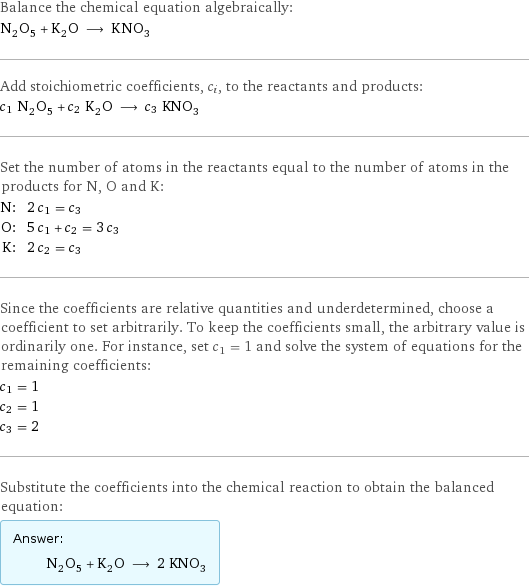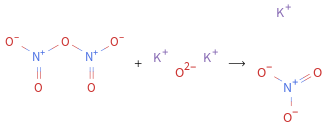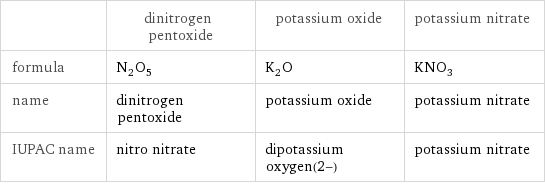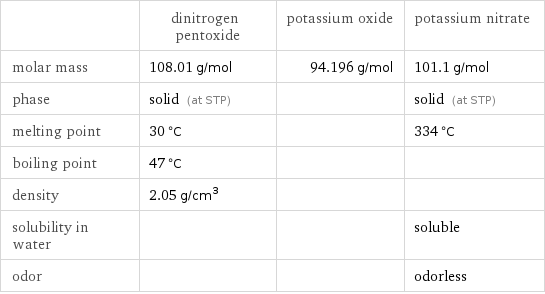Input interpretation

N_2O_5 dinitrogen pentoxide + K_2O potassium oxide ⟶ KNO_3 potassium nitrate
Balanced equation

Balance the chemical equation algebraically: N_2O_5 + K_2O ⟶ KNO_3 Add stoichiometric coefficients, c_i, to the reactants and products: c_1 N_2O_5 + c_2 K_2O ⟶ c_3 KNO_3 Set the number of atoms in the reactants equal to the number of atoms in the products for N, O and K: N: | 2 c_1 = c_3 O: | 5 c_1 + c_2 = 3 c_3 K: | 2 c_2 = c_3 Since the coefficients are relative quantities and underdetermined, choose a coefficient to set arbitrarily. To keep the coefficients small, the arbitrary value is ordinarily one. For instance, set c_1 = 1 and solve the system of equations for the remaining coefficients: c_1 = 1 c_2 = 1 c_3 = 2 Substitute the coefficients into the chemical reaction to obtain the balanced equation: Answer: | | N_2O_5 + K_2O ⟶ 2 KNO_3
Structures

+ ⟶
Names

dinitrogen pentoxide + potassium oxide ⟶ potassium nitrate
Equilibrium constant
![Construct the equilibrium constant, K, expression for: N_2O_5 + K_2O ⟶ KNO_3 Plan: • Balance the chemical equation. • Determine the stoichiometric numbers. • Assemble the activity expression for each chemical species. • Use the activity expressions to build the equilibrium constant expression. Write the balanced chemical equation: N_2O_5 + K_2O ⟶ 2 KNO_3 Assign stoichiometric numbers, ν_i, using the stoichiometric coefficients, c_i, from the balanced chemical equation in the following manner: ν_i = -c_i for reactants and ν_i = c_i for products: chemical species | c_i | ν_i N_2O_5 | 1 | -1 K_2O | 1 | -1 KNO_3 | 2 | 2 Assemble the activity expressions accounting for the state of matter and ν_i: chemical species | c_i | ν_i | activity expression N_2O_5 | 1 | -1 | ([N2O5])^(-1) K_2O | 1 | -1 | ([K2O])^(-1) KNO_3 | 2 | 2 | ([KNO3])^2 The equilibrium constant symbol in the concentration basis is: K_c Mulitply the activity expressions to arrive at the K_c expression: Answer: | | K_c = ([N2O5])^(-1) ([K2O])^(-1) ([KNO3])^2 = ([KNO3])^2/([N2O5] [K2O])](../image_source/bddc7dfb38455f26f53b9741ecb50f7f.png)
Construct the equilibrium constant, K, expression for: N_2O_5 + K_2O ⟶ KNO_3 Plan: • Balance the chemical equation. • Determine the stoichiometric numbers. • Assemble the activity expression for each chemical species. • Use the activity expressions to build the equilibrium constant expression. Write the balanced chemical equation: N_2O_5 + K_2O ⟶ 2 KNO_3 Assign stoichiometric numbers, ν_i, using the stoichiometric coefficients, c_i, from the balanced chemical equation in the following manner: ν_i = -c_i for reactants and ν_i = c_i for products: chemical species | c_i | ν_i N_2O_5 | 1 | -1 K_2O | 1 | -1 KNO_3 | 2 | 2 Assemble the activity expressions accounting for the state of matter and ν_i: chemical species | c_i | ν_i | activity expression N_2O_5 | 1 | -1 | ([N2O5])^(-1) K_2O | 1 | -1 | ([K2O])^(-1) KNO_3 | 2 | 2 | ([KNO3])^2 The equilibrium constant symbol in the concentration basis is: K_c Mulitply the activity expressions to arrive at the K_c expression: Answer: | | K_c = ([N2O5])^(-1) ([K2O])^(-1) ([KNO3])^2 = ([KNO3])^2/([N2O5] [K2O])
Rate of reaction
![Construct the rate of reaction expression for: N_2O_5 + K_2O ⟶ KNO_3 Plan: • Balance the chemical equation. • Determine the stoichiometric numbers. • Assemble the rate term for each chemical species. • Write the rate of reaction expression. Write the balanced chemical equation: N_2O_5 + K_2O ⟶ 2 KNO_3 Assign stoichiometric numbers, ν_i, using the stoichiometric coefficients, c_i, from the balanced chemical equation in the following manner: ν_i = -c_i for reactants and ν_i = c_i for products: chemical species | c_i | ν_i N_2O_5 | 1 | -1 K_2O | 1 | -1 KNO_3 | 2 | 2 The rate term for each chemical species, B_i, is 1/ν_i(Δ[B_i])/(Δt) where [B_i] is the amount concentration and t is time: chemical species | c_i | ν_i | rate term N_2O_5 | 1 | -1 | -(Δ[N2O5])/(Δt) K_2O | 1 | -1 | -(Δ[K2O])/(Δt) KNO_3 | 2 | 2 | 1/2 (Δ[KNO3])/(Δt) (for infinitesimal rate of change, replace Δ with d) Set the rate terms equal to each other to arrive at the rate expression: Answer: | | rate = -(Δ[N2O5])/(Δt) = -(Δ[K2O])/(Δt) = 1/2 (Δ[KNO3])/(Δt) (assuming constant volume and no accumulation of intermediates or side products)](../image_source/26d30618d5237e50fa16b1c877e1a5d4.png)
Construct the rate of reaction expression for: N_2O_5 + K_2O ⟶ KNO_3 Plan: • Balance the chemical equation. • Determine the stoichiometric numbers. • Assemble the rate term for each chemical species. • Write the rate of reaction expression. Write the balanced chemical equation: N_2O_5 + K_2O ⟶ 2 KNO_3 Assign stoichiometric numbers, ν_i, using the stoichiometric coefficients, c_i, from the balanced chemical equation in the following manner: ν_i = -c_i for reactants and ν_i = c_i for products: chemical species | c_i | ν_i N_2O_5 | 1 | -1 K_2O | 1 | -1 KNO_3 | 2 | 2 The rate term for each chemical species, B_i, is 1/ν_i(Δ[B_i])/(Δt) where [B_i] is the amount concentration and t is time: chemical species | c_i | ν_i | rate term N_2O_5 | 1 | -1 | -(Δ[N2O5])/(Δt) K_2O | 1 | -1 | -(Δ[K2O])/(Δt) KNO_3 | 2 | 2 | 1/2 (Δ[KNO3])/(Δt) (for infinitesimal rate of change, replace Δ with d) Set the rate terms equal to each other to arrive at the rate expression: Answer: | | rate = -(Δ[N2O5])/(Δt) = -(Δ[K2O])/(Δt) = 1/2 (Δ[KNO3])/(Δt) (assuming constant volume and no accumulation of intermediates or side products)
Chemical names and formulas

| dinitrogen pentoxide | potassium oxide | potassium nitrate formula | N_2O_5 | K_2O | KNO_3 name | dinitrogen pentoxide | potassium oxide | potassium nitrate IUPAC name | nitro nitrate | dipotassium oxygen(2-) | potassium nitrate
Substance properties

| dinitrogen pentoxide | potassium oxide | potassium nitrate molar mass | 108.01 g/mol | 94.196 g/mol | 101.1 g/mol phase | solid (at STP) | | solid (at STP) melting point | 30 °C | | 334 °C boiling point | 47 °C | | density | 2.05 g/cm^3 | | solubility in water | | | soluble odor | | | odorless
Units
